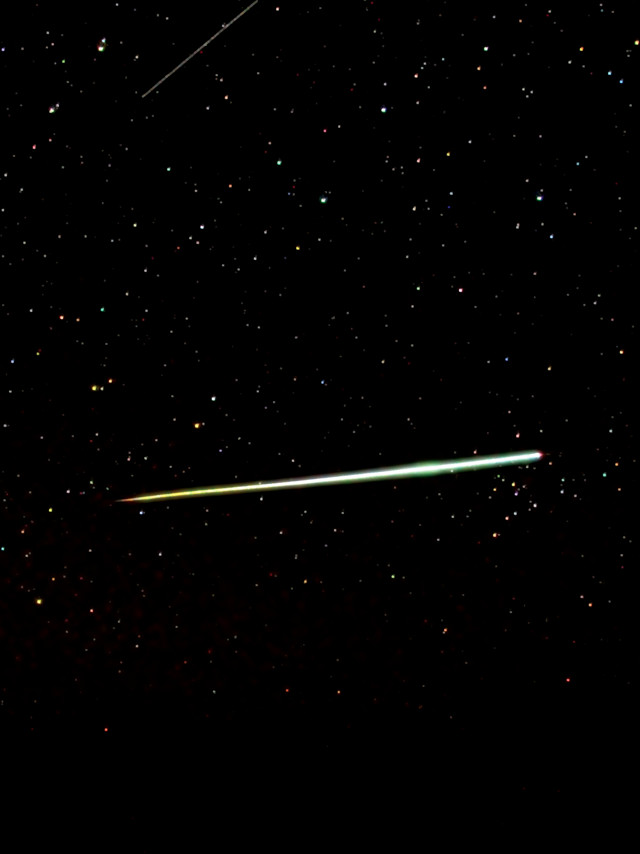
by Sam Lemonick Wednesday, August 9, 2017

A meteor streaks through the night sky over South Australia. Credit: C m handler, CC BY-SA 3.0.
Keen-eared observers sometimes report hearing popping, whistling or buzzing at the same time they see meteors pass far overhead, a perplexing phenomenon called the electrophonic effect. What causes the effect — or if it’s even real — has been discussed for centuries; famed astronomer Edmond Halley is said to have dismissed it as a figment of people’s imaginations. In a new study in Geophysical Research Letters, researchers suggest that not only is it real, but that it is caused by radio waves induced by meteors and converted to sound waves near Earth’s surface.
Meteors tend to become visible as they burn up in the atmosphere about 80 to 120 kilometers above Earth’s surface. Any related noise that people might hear cannot be the sound of the meteors striking the atmosphere. For one thing, sound waves emanating directly from meteors are likely to be absorbed by the atmosphere. Additionally, because sound travels about 1 million times slower in air than light does, by the time any sound from a meteor reached the ground, the visible light from it would be long gone.
In the new study, Michael Kelley, an emeritus electrical engineering professor at Cornell University, and Colin Price, an atmospheric scientist at Tel Aviv University in Israel, noted that meteors shed ions and electrons as they pass through the atmosphere. These particles interact with Earth’s magnetic field to create electrical currents, Kelley says, which in turn generate an electric field in the atmosphere.
The researchers suggest that this field is strong enough to drive electromagnetic waves — at radio frequencies — that travel at the speed of light and interact with metal structures on the planet’s surface, like buildings or even metal eyeglass frames. These metal objects then sometimes convert the electromagnetic waves to sound waves audible to humans. Although other researchers have previously proposed this latter occurrence as part of the electrophonic effect, Kelley and Price detail how charged particles from a meteor could create a strong electric field in the first place.
Drawing on previous research that measured electric and magnetic fields on Earth’s surface in conjunction with meteor showers, as well as separate work describing the sounds meteors make, the researchers modeled the phenomenon mathematically. Key to the model was relating the size of the plasma coma — a cloud of charged particles that follows a meteor through the atmosphere — as well as meteor velocity to the strength of the electromagnetic field produced.
Kelley and Price aren’t the only researchers attempting to explain the electrophonic phenomenon. In February, a group led by the late Richard Spalding, an engineer at Sandia National Laboratories in New Mexico, published its own idea in Scientific Reports.
Spalding’s team suggests that rapidly flickering light given off by meteors heats up materials around the listener, including grass, clothing and hair. This heating causes changes in air pressure around those objects, which then produces sounds some people can hear. The group replicated the effect in the lab, heating hair, fibers, paint and other materials, which then produced sound.
Kelley says he thinks this explanation could also be at work in some cases, but notes that electrophonic sounds reported in past research were associated with meteors too dim to fit Spalding’s team’s hypothesis.
John Tencer, also an engineer at Sandia and one of Spalding’s co-authors on the Scientific Reports study, says he agrees that both explanations could theoretically contribute to electrophonic sounds related to meteors. “If somebody happened to be standing by an antenna, both mechanisms would likely contribute to whatever sound they hear,” Tencer says. However, he says, Kelley and Price don’t provide evidence directly linking meteor-induced electric fields to audible noise on the ground.
Dennis Gallagher, a physicist at NASA’s Marshall Space Flight Center in Alabama, says the researchers need to provide more evidence that meteors can create the specific kind of electric fields that would lead to sounds at Earth’s surface. “That connection’s not made,” Gallagher says.
It’s unclear whether Kelley, now retired, will further develop the new idea, but he says he thinks the hypothesis could explain other mysterious atmospheric sounds people report hearing, like hissing and crackling from auroras.
© 2008-2021. All rights reserved. Any copying, redistribution or retransmission of any of the contents of this service without the expressed written permission of the American Geosciences Institute is expressly prohibited. Click here for all copyright requests.